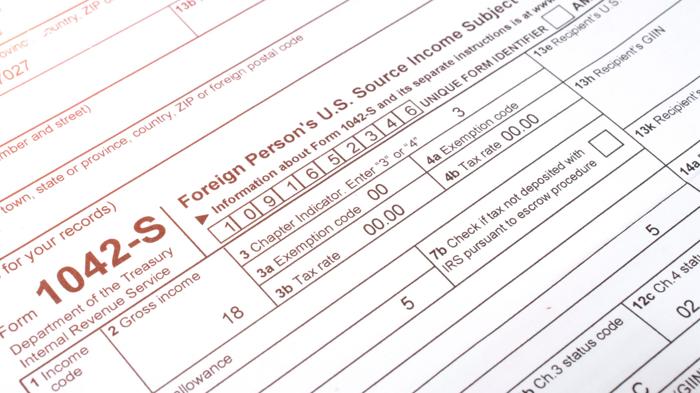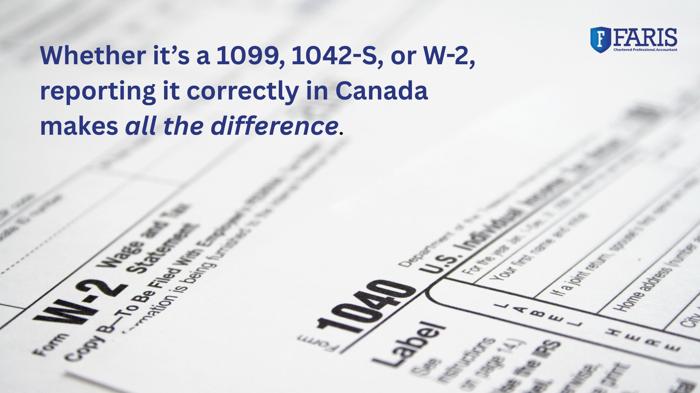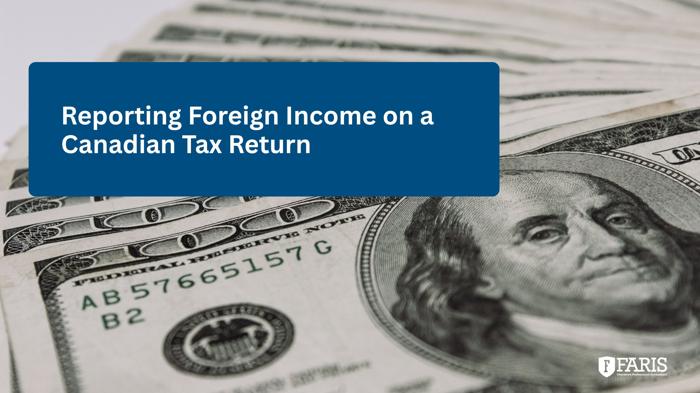Canadian resident taxpayers are taxable in Canada on their worldwide income. Foreign-source income may have already been subject to foreign taxes paid. Where this is the case, the taxpayer may be eligible for a deduction or a credit in respect to foreign business and non-business taxes paid. The tax credit or deduction can reduce the tax otherwise payable on that income to Nil, but can never be used to reduce the taxes payable on income NOT from that particular foreign jurisdiction.
Canadian residents are taxed on their worldwide income. What determines residency?
Residency is a question of fact that looks at a taxpayer’s mode of living to determine their economic allegiance. In addition to common-law factors that are considered when making residency determinations, tax treaties and deeming rules in the Income Tax Act have to be considered.
Generally, taxpayers may be resident in Canada for tax purposes if they:
- Have a permanent address in Canada;
- Have a close relative/immediate family in Canada;
- Have Canadian bank accounts and credit cards, Canadian insurance, or a Canadian driver’s license; or
- Make regular visits to Canada to visit immediate family.
No factor is determinative. What the courts are looking for is sufficient social and economic ties to Canada that justify taxing that person’s worldwide income.
Tax Forms Related to Foreign Income
When earning income from outside Canada, you may receive tax documents from the country where the income originated. These forms often provide essential details for accurately declaring that income in Canada. For example, individuals with U.S. income might receive one or more forms from the Internal Revenue Service (IRS). Examples include:
The 1099 series is widely used for various types of U.S. income, including dividends, interest, royalties, and self-employment income. Each variant within the series, such as Form 1099-DIV for dividends or Form 1099-INT for interest, summarizes the amount paid and, in some cases, any taxes withheld at source.
Form 1042-S applies when certain types of U.S.-sourced income, such as interest, dividends, or other passive income, are paid to non-residents. It shows the gross income amount and the U.S. withholding tax applied, which may be relevant when determining foreign tax credits in Canada.
The key difference between a 1099 and a 1042-S lies in who receives the form and how the U.S. tax rules apply to them.
1099 series:
- Issued to U.S. tax residents (including U.S. citizens and resident aliens) as well as some others considered U.S. persons for tax purposes.
- Reports various types of income, such as dividends (1099-DIV), interest (1099-INT), and non-employee compensation (1099-NEC).
- Generally does not have U.S. withholding at source for residents because the recipient is expected to handle tax obligations through their U.S. tax return.
1042-S:
- Issued to non-U.S. residents (nonresident aliens) for certain types of U.S.-sourced income, such as interest, dividends, royalties, and some service payments.
- Shows the gross amount paid and the withholding tax applied, usually at the rate specified by U.S. tax law or a tax treaty.
- The withholding is often final for the U.S. side unless the recipient files a U.S. nonresident tax return to claim a refund or adjust the amount.
In short, 1099s are for U.S. persons with no or minimal withholding; 1042-S forms are for non-U.S. persons with withholding applied at the time of payment.
For a Canadian taxpayer, either form can be important when reporting foreign income because they provide official documentation of the amount earned and any foreign tax withheld.

A 1099 form from the U.S. may show income without withholding, meaning Canadian tax will generally be owed in full unless foreign tax credits apply for other reasons. A 1042-S, on the other hand, often shows U.S. withholding already applied, which may be used to claim a foreign tax credit in Canada to avoid double taxation.
There is also the W-2 form, which is issued to employees for wages earned in the United States, detailing gross income, federal and state taxes withheld, and other payroll-related deductions. Canadians who worked for a U.S. employer may receive this form to support income calculations and withholding verification.
Keeping both the form and any accompanying statements from any foreign jurisdiction helps support your reporting in case the Canada Revenue Agency (CRA) requests proof.
Reporting Foreign Assets & Required Forms
Canadians who own certain foreign assets may be required to disclose these holdings to the CRA, even if the assets did not produce income during the year. The rules are designed to ensure transparency in cross-border asset ownership and to help Canada enforce tax compliance related to offshore investments.
One of the most common obligations is filing the Foreign Income Verification Statement Form T1135. This form applies when the total cost amount of specified foreign property, such as foreign bank accounts, investment portfolios, or rental real estate outside Canada, exceeds CAD $100,000 at any point during the year. The T1135 requires detailed disclosure, including the type of property, the country in which it is located, and any income generated.
Examples of foreign properties that must be reported
Foreign real estate that is not used primarily as a personal residence may also need to be reported. For example, a rental condo in Florida or an investment property in Europe typically qualifies as specified foreign property. Similarly, shares of foreign corporations held outside registered Canadian accounts, precious metals stored abroad, and interests in foreign trusts may also fall within reporting requirements.
Other documentation you may need
In addition to the T1135, certain situations may involve other documentation. For instance, Canadian residents with foreign business interests may need to maintain corporate records from the jurisdiction of incorporation, while those holding foreign bank accounts should keep account statements showing balances and transaction history. Where a tax treaty applies, supporting documents related to treaty benefits claimed should also be retained.
Failing to file required forms such as the T1135 can result in significant penalties, even if no tax is owed, so make sure you file all forms on time to avoid costly consequences.

How to Report Foreign Income
Reporting foreign income on a Canadian tax return involves identifying all sources of income earned outside Canada and ensuring they are correctly converted, documented, and disclosed. The CRA requires Canadian residents to report worldwide income on their T1 income tax package, regardless of where it was earned or whether it has already been taxed in another country.
Gather all relevant “paperwork”
The first step is to gather all relevant documentation, such as U.S. forms like the 1099 series, 1042-S, or W-2, or equivalent slips from other jurisdictions. These documents provide the amounts earned and any foreign tax withheld, which are needed for both income reporting and potential foreign tax credit claims. All foreign amounts must be converted to Canadian dollars using the exchange rate in effect on the date the income was received or an average annual rate if the payments were recurring.
Filling out the proper forms
Depending on the type of income, different sections of the T1 return will be used. Employment income is generally reported on line 10400, business and professional income on the appropriate self-employment schedules, and investment income on lines such as 12100 (interest) or 12000 (dividends). If foreign tax has been paid, Form T2209 – Federal Foreign Tax Credits helps calculate the allowable credit to reduce double taxation.
If foreign assets meet the reporting threshold, Form T1135 – Foreign Income Verification Statement may also be required in addition to reporting the income itself. The key is to ensure that every foreign income source is both disclosed and supported by proper records so that the CRA has a complete picture of your taxable income. Thorough and accurate reporting protects against compliance issues and ensures eligibility for available tax relief.
Voluntary Disclosures and Past Non-Compliance
Not reporting foreign income or assets can create years of tax headaches — but it doesn’t have to end in penalties and interest piling up. The Canada Revenue Agency (CRA) offers a way for taxpayers to come forward before they’re caught, fix the problem, and limit the damage.
Using the Voluntary Disclosures Program
The Voluntary Disclosures Program (VDP) is designed for people who realize they’ve left something out of their tax filings, including unreported foreign earnings or missed forms like the T1135. If the CRA accepts your application, you can often avoid penalties and get a break on some of the interest, as long as you pay the taxes that were owed. The catch? You have to apply before the CRA contacts you about the issue, and your disclosure must be complete and truthful.
Steps to get back on track
- Pull together your records. This includes foreign income slips, bank statements, real estate documents, past returns, and anything else that tells the full financial story.
- Identify every gap. Review each year you may have missed income or failed to file a required form.
- Prepare corrected returns. Include all the missing information and the right foreign reporting forms.
- Submit the disclosure package. The VDP application (Form RC199) goes to the CRA along with your supporting documents.
- Wait for a decision. If approved, you’ll pay what’s owed with reduced penalties and interest.
You generally only get one chance to make a successful VDP application, and, if accepted, how you word your application determines what type of relief you may receive. Don’t take chances, talk to us at Faris CPA before starting your application. We specialize in high-stakes tax issues.
Why acting early matters
Once the CRA starts asking questions, the voluntary route is usually off the table. Coming forward first shows good faith, and it can turn a potentially costly problem into a manageable one. Acting quickly also means fewer years of unreported income to fix and fewer sleepless nights wondering if the CRA will find the gap.

Tax Planning and Management Tips
Managing foreign income and assets requires more than simply meeting annual filing obligations. With the right tax planning strategies, you can reduce the risk of non-compliance, take advantage of available tax relief, and position yourself for better long-term outcomes.
Keep detailed and accessible records
Accurate documentation is the foundation of effective tax management. Maintain copies of foreign income slips (such as U.S. 1099s, 1042-S, or W-2 forms), bank statements, real estate contracts, and investment account summaries. Store both physical and digital copies in an organized system so you can quickly respond to any CRA requests. Good recordkeeping also makes it easier to calculate foreign tax credits and verify treaty benefits.
Understand currency conversion rules
Foreign income must be reported in Canadian dollars. Use the Bank of Canada’s annual average exchange rate for recurring income streams, or the daily rate for one-time transactions. Being consistent with your method each year ensures the CRA can trace your calculations and reduces the risk of disputes.
Make use of tax treaties
Canada has tax treaties with many countries to prevent double taxation. These treaties can lower the withholding tax on certain types of income or clarify which country has taxing rights. Familiarizing yourself with the treaty between Canada and the country where your income is earned can help you structure your investments or contracts in a more tax-efficient way.
Consider the timing of income and expenses
If you have flexibility in when income is received or expenses are paid, timing can make a difference. For example, deferring foreign income to a year when you have higher foreign tax credits available could reduce your net Canadian tax payable. Similarly, prepaying deductible expenses before year-end can help offset income in the current tax year.
Use our professional support for complex assets
Foreign businesses, partnerships, or trusts often have unique reporting requirements beyond standard income disclosure. Our professionals have cross-border experience and can help you identify obligations you might otherwise miss and recommend ways to structure holdings for efficiency and compliance. This is especially important when your assets span multiple jurisdictions with different tax rules.
Review your position annually
Tax laws and treaty provisions can change, and your own financial situation may shift. An annual review of your foreign holdings, income sources, and reporting requirements ensures you remain compliant and ready to take advantage of new opportunities.
In Conclusion
Managing foreign income and assets is about more than meeting the CRA’s annual requirements. It also helps you build a system that keeps you informed, prepared, and in control of all your finances year-round.
One often-overlooked advantage of consistent, proactive management is that it creates a clear financial history. This not only reduces stress during tax season but can also make future financial decisions, such as applying for financing, securing investment partners, or restructuring assets, far more straightforward. Lenders, investors, and even business partners view organized, transparent records as a sign of credibility and stability.
We’re here to help you save more of your money
If your current process for tracking and reporting foreign income feels more reactive than strategic, now is the time to make a change. Faris CPA works with clients to implement custom systems for cross-border income and asset management, ensuring you meet Canadian tax obligations while making the most of available credits, deductions, and treaty benefits.
With our specialized expertise in complex reporting, past non-compliance resolutions, and tax planning for international holdings, we help you avoid costly mistakes and position your finances for long-term success.
Contact Faris CPA today to protect your compliance standing and unlock the full potential of your foreign income and assets.
FAQS
Do I have to declare foreign income in Canada?
Whether you live in Canada or are a deemed resident of Canada who lives in another country, you have to report all of your international income on your return. However, you may be able to claim a credit for any foreign tax you have paid on your income.
How does CRA know about foreign income?
Along with these tax treaties come information-sharing agreements. For example, the CRA in Canada and the IRS in the United States have an agreement where they share earnings information for citizens from each other’s countries. This means the CRA likely knows how much income you made from the US, and if you underreport or withhold that information, you risk being penalized and paying far more in the long run.
Are offshore accounts illegal in Canada?
An offshore bank refers to a bank located outside of the investor’s country of residence or domicile. It provides banking services mainly for clients who are not physically residing in the country of the bank. Offshore banking in Canada is legal as long as funds are disclosed to the Canadian tax authorities.




